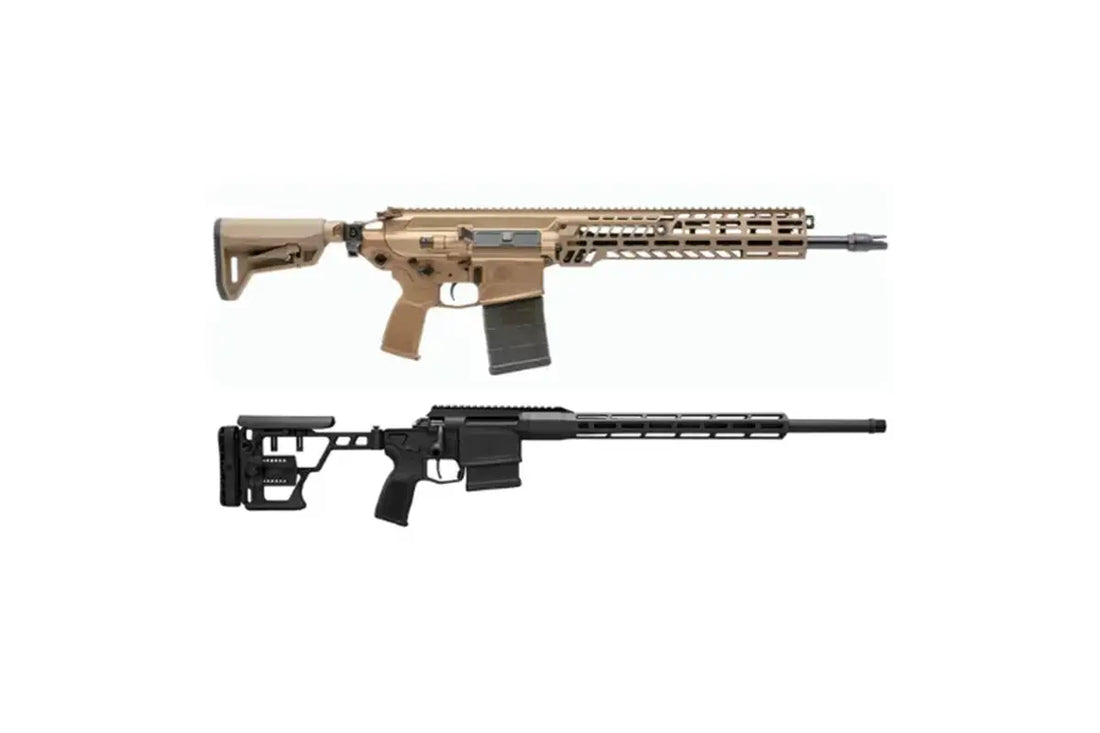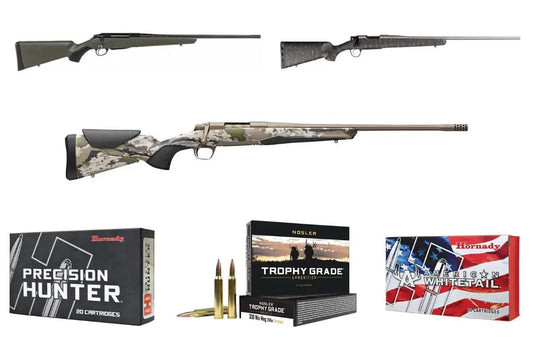
277 Fury vs. .308 Winchester: Can SIG’s 80,000-PSI Hot-Rod Really Dethrone the King?
|
Key Metric |
.277 Fury (6.8 × 51 mm) |
.308 Winchester (7.62 × 51 mm) |
Why It Matters |
|
Case design |
Hybrid brass-steel-aluminum; small-rifle primer |
Conventional brass; large-rifle primer |
Hybrid lets the Fury safely run 80,000 psi—~30 % higher pressure |
|
SAAMI max pressure |
80,000 psi |
62,000 psi |
Pressure drives velocity from short barrels |
|
Typical factory load |
135 gr Hybrid Match @ 3,000 fps (16″ barrel) |
168 gr ELD-Match @ 2,700 fps (24″ barrel) |
Apples-to-apples, Fury is ≈200–250 fps faster from eight inches less tube |
|
Muzzle energy |
2,694 ft-lb (135 gr @ 3 000 fps) |
2,719 ft-lb (168 gr @ 2 700 fps) |
Nearly identical energy, but Fury gets there with lower recoil impulse |
|
Ballistic coefficient |
G7 ≈ 0.275 (135 gr) |
G7 ≈ 0.250 (168 gr) |
Higher BC + velocity = 20–25 % less wind drift past 600 yd |
|
Barrel life (est.) |
2 – 4 k rds (speculative) |
5 – 7 k rds (match loads) |
80 k psi erodes throats faster—see Ron Spomer quote below |
|
Factory rifle options (2025) |
SIG MCX SPEAR, CROSS PRS, Fix by Q (in-letted) |
Hundreds—Ruger American, Tikka T3x, SCAR-17, Springfield M1A, etc. |
Choice & price still favor .308 |
|
Match / hunting ammo street price |
$3.50–$4.25 per round (limited) |
$1.25–$1.75 per round (abundant) |
Early-adopter tax is very real |
|
Recoil in 8 lb rifle |
≈ 15 ft-lb |
≈ 17.5 ft-lb |
Fury feels like 6.5 Creed; .308 is noticeably sharper |
|
SAAMI release |
2023, “transonic-proofed” |
1952, global standard |
.308’s logistics network is unmatched |
|
Bottom-line niche |
Lightweight suppressed carbines, future battle rifles, long-range hunting where shot count is low |
General-purpose everything—plinking to elk to Palma match |
Different use-cases more than direct replacement |
“This steel-headed cartridge is a modified, necked-down .308 that delivers from a 16-inch barrel what the old .270 Win does from a 24-inch barrel.”
—Ron Spomer, outdoor writer
The firearms blogosphere hasn’t seen a caliber ignite this much forum heat since 6.5 Creedmoor went viral. SIG Sauer’s .277 Fury (officially 6.8 × 51 mm) promises magnum-class exterior ballistics out of short, suppressor-friendly barrels—thanks to a novel hybrid case and eye-watering chamber pressure. But ballistic promises are cheap; how does Fury fare against the evergreen .308 Winchester that’s filled freezers and sniper logs for 70 years? Below is a brutally honest, data-driven comparison for hunters, long-range nerds, and armchair commandos alike.
1. Pressure Is the Game-Changer
- Fury: 80,000 psi is 18,000 psi over SAAMI’s previous ceiling. That’s possible because a stainless-steel base is mechanically locked to a brass body, preventing primer cratering and case-head expansion.
- .308: Capped at 62,000 psi in modern rifles. Match hand-loaders rarely push past 58,000 psi to preserve brass.
Pros of Fury’s Over-Pressure Approach
- +200–300 fps from equal barrel length—vital when every inch under a suppressor matters.
- Smaller powder charge than a true magnum, so it burns cleaner and can use faster powders for better flash suppression.
- Less case stretch = longer brass life for reloaders despite high psi.
Cons
- Requires purpose-built actions—your vanilla Rem 700 will kaboom.
- Reloading tooling is scarce and pricey.
- Hopeless in straight-pull or roller-delayed guns not engineered for 80 k.
2. Real-World Ballistics
Wind Drift & Drop
Running Hornady’s 4DOF solver, a 135 gr Fury Hybrid Match at 3,000 fps stays supersonic to ~1,500 yd. A 168 gr .308 ELD-Match at 2,700 fps falls sub-M at 1,200 yd. At 1,000 yd the Fury deflects 27.6 in. in a 10-mph cross-wind; .308 drifts 34.4 in.—a 20 % edge.
Energy on Target
Energy parity at the muzzle tilts Fury’s way down-range:
- 500 yd energy: Fury 1,793 ft-lb vs. .308 1,364 ft-lb (Hornady factory tables). That’s the difference between punching through a pronghorn shoulder or merely cracking a rib.
Barrel Life Reality Check
“Certainly 80,000 psi argues for early breakdown, but the Fury’s modest powder column argues against it.” —Ron Spomer
Most gunsmiths we polled expect 2,500–3,500 rounds of sub-MOA accuracy before a re-barrel, roughly on par with 6.5 Creed. High-volume PRS shooters burning 4 k-plus rounds a season will hate that cadence; hunters who fire 40 rounds a year won’t notice.
3. Terminal Performance in the Field
|
Scenario |
Why Fury Wins |
Why .308 Still Works |
|
Western elk, 400 yd |
140 gr Controlled-Fracture + 2 100 ft-lb = deeper penetration, flatter flight |
180 gr AccuBond @ 2 500 fps retains weight; proven on thousands of bulls |
|
Dense-brush whitetail |
Faster expansion of polymer-tip helps at 50 yd |
Cheap 150 gr soft-points hammer deer and cost $18/box |
|
Barrier defeat (LE) |
Steel-tip projectiles remain intact after windshield |
M80A1 EPR exists in .308 supply chain now |
|
Long-range steel |
Less drop = fewer dope corrections |
Heavier .30 pills (200+ gr) buck wind extremely well |
4. Platform & Accessory Ecosystem
Fury
- SIG MCX SPEAR (civilian XM7 clone) — 13″ or 16″ barrel; two-round burst trigger; ships with SLX suppressor.
- SIG CROSS PRS — 24″ stainless barrel for NRL Hunter; 8 lb chassis.
- FIX by Q (2025 limited run) — sub-6 lb folder for back-country elk.
All use proprietary magazines that hide a reinforced feed lip to accommodate the case’s steel rim. After-market barrels run $800–$1 100 due to the novel extension pattern.
.308
· Ruger American Rifle ($550) with Magpul Hunter stock is a 1 MOA setup under $1k.
· FN SCAR-17 S or HK 417 clones have decades of parts support.
· GA Precision M24 clones routinely print 0.3 MOA with 185 Juggernauts.
Verdict: If you like to tinker, .308 offers endless barrels, gas systems, and cheap mags. Fury will catch up—but not before 2027 in my view.
5. Cost of Ownership
|
Item |
Fury |
.308 |
|
Match ammo (2025 street) |
$70–$85 per 20 |
$25–$35 per 20 |
|
Brass (100 ct) |
$190 hybrid cases |
$65 Lapua brass |
|
Die set |
$280 (Redding proprietary) |
$70 (any brand) |
|
Re-barrel |
$750 (steel-liner spec) |
$450 |
Until SIG licenses the hybrid case to third parties—Fury will stay a premium proposition. That said, you spent $2k on carbon trekking poles; don’t pretend ammo cost keeps you up at night.
6. Reliability & Safety
Hybrid cases exhibit zero incipient head separation in government endurance tests (20 k cycles). However, light firing-pin strikes are lethal to 80 k systems—the primer cup is simply harder. SIG addressed this with a heavier AR-10-sized pin and reduced firing-pin channel clearance. Early adopters swapping lowers should measure protrusion with a go-depth gauge.
7. Our Take — Who Should Switch?
- Mountain hunters running suppressed 16″ carbines who want .270-class external ballistics without a 24″ pipe.
- Departments fielding the MCX SPEAR—logistical commonality trumps ammo price.
- Ballistics hipsters bored of their 22 GT and desperate for forum clout.
Stay with .308 if you’re a high-volume match shooter, or you value ammo availability in a supply crunch. In pure lethality the rounds are a wash inside 600 yd; beyond that Fury’s flatter arc and higher impact velocity do matter—but so does your ability to read mirage.
8. The Future, Speculatively
- SIG has already necked the case to 6 mm Fury; expect a 105 gr load at 3 350 fps from an 18″ barrel—6 CM performance minus eight inches of steel.
- A digital pressure-sensing primer (think piezoelectric cup) is reportedly being beta-tested, allowing real-time chamber pressure readouts piped to SIG’s BDX scopes.
- Don’t be shocked if a major hunting-ammo brand releases a lead-free, bonded copper 140 gr Fury for California compliance by fall 2026.
Bottom Line
Is the .277 Fury objectively “better” than .308? Yes—for the shooter who values short-barrel efficiency, long-range drop, and suppressed handling over ammo cost and platform diversity. For everyone else, the .308 remains the Honda Civic of rifle cartridges: inexpensive, ubiquitous, and still surprisingly capable.
Shop premium .277 Fury firearms & ammunition at PalmettoStateArmory.com.



